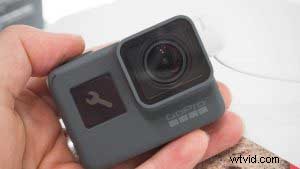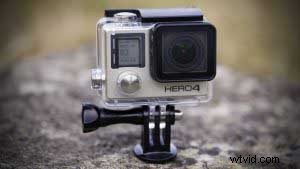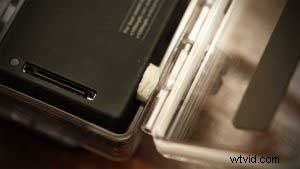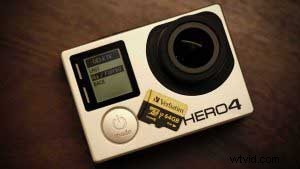Każdy model GoPro Hero wnosi coś nowego do formatu kamer akcji, opierając się na funkcjach i możliwościach poprzedniego. Głównym celem kamer GoPro jest po prostu uchwycenie akcji na bieżąco, więc jeśli, jak większość użytkowników, po prostu chcesz chwycić kamerę i ruszyć prosto w drogę, to GoPro jest dla Ciebie idealną opcją.
GoPro Hero został zaprojektowany do rejestrowania oszałamiających materiałów przy minimalnym zamieszaniu. Jeśli jednak potrzebujesz więcej opcji niż zwykłe nagrywanie, kamera GoPro Hero Black oferuje wysokiej jakości zaawansowane ustawienia, dzięki którym ta kamera jest popularna w branży telewizyjnej.
 Pod koniec 2016 roku GoPro uprościło zasięg jeszcze bardziej niż kiedykolwiek wcześniej dzięki zaledwie dwóm kamerom; GoPro Hero5 Black i GoPro Hero5 Session zostały zaprezentowane na targach Photokina 2016. Konstrukcja obu sprawia, że korzystanie z nich jest jeszcze łatwiejsze niż kiedykolwiek. Jeśli chcesz dowiedzieć się więcej, sprawdź nasze wstępne wrażenia i porównania między najnowszymi Hero5 Black i Hero4 Czarny.
Pod koniec 2016 roku GoPro uprościło zasięg jeszcze bardziej niż kiedykolwiek wcześniej dzięki zaledwie dwóm kamerom; GoPro Hero5 Black i GoPro Hero5 Session zostały zaprezentowane na targach Photokina 2016. Konstrukcja obu sprawia, że korzystanie z nich jest jeszcze łatwiejsze niż kiedykolwiek. Jeśli chcesz dowiedzieć się więcej, sprawdź nasze wstępne wrażenia i porównania między najnowszymi Hero5 Black i Hero4 Czarny.
Nowe modele mają sporo zmian i przyjrzymy się im, gdy tylko aparat zostanie wprowadzony na rynek. Na razie przyjrzymy się serii Hero4 oraz kilku funkcjom i ustawieniom, które są wspólne dla Hero, Hero4 Silver i Hero4 Black.
ZOBACZ WIĘCEJ: Kompletny przewodnik po GoPro Hero i kamerach sportowych dla początkujących
Zdejmowanie wodoodpornej obudowy GoPro Hero
 Gdy dostarczane są kamery, każda kamera GoPro jest chroniona wodoszczelną obudową. W srebrnych i czarnych wersjach GoPro należy zdjąć obudowę przed naładowaniem kamery, włożeniem karty pamięci lub podłączeniem do telewizora.
Gdy dostarczane są kamery, każda kamera GoPro jest chroniona wodoszczelną obudową. W srebrnych i czarnych wersjach GoPro należy zdjąć obudowę przed naładowaniem kamery, włożeniem karty pamięci lub podłączeniem do telewizora.
Wodoodporna obudowa jest zamykana za pomocą zacisku kompresyjnego, aby ją zwolnić, wystarczy ją otworzyć. W przypadku kamery w wersji Silver i Black odwróć obudowę otworem skierowanym w dół i delikatnie dotknij dłonią pod spodem, a kamera wypadnie.
Hero to kamera poziomu podstawowego, a wodoodporna obudowa jest zamocowana na miejscu, po zdjęciu tylnej części masz bezpośredni dostęp do gniazd USB i kart MicroSD.
W przypadku wszystkich aparatów, jeśli chodzi o ponowne zamknięcie obudowy, upewnij się, że uszczelka jest wolna od kurzu lub materiału, wszystko, co blokuje uszczelkę, może wpłynąć na jakość wodoodporności obudowy, a następnie zamknąć zacisk.
ZOBACZ WIĘCEJ: 5 szybkich wskazówek GoPro Hero, aby w pełni wykorzystać możliwości kamery sportowej
Ładowanie baterii
 GoPro mają wbudowaną ładowarkę przez USB (USB micro), którą po prostu podłącza się bezpośrednio z boku GoPro a następnie do wybranej ładowarki. Jeśli możesz użyć wtyczki USB, która idzie bezpośrednio do ściany, ponieważ prawie na pewno będzie to połączenie 2-amperowe, a nie 1-amperowe. Wszystko to oznacza, że Twoje GoPro ładuje się o wiele szybciej.
GoPro mają wbudowaną ładowarkę przez USB (USB micro), którą po prostu podłącza się bezpośrednio z boku GoPro a następnie do wybranej ładowarki. Jeśli możesz użyć wtyczki USB, która idzie bezpośrednio do ściany, ponieważ prawie na pewno będzie to połączenie 2-amperowe, a nie 1-amperowe. Wszystko to oznacza, że Twoje GoPro ładuje się o wiele szybciej.
The GoPro Hero has the USB port positioned on the back of the camera.
Storage
All GoPro’s take a form of memory card called a MicroSD card. These small cards are commonly used in mobile devises and range in capacities from 1GB to 512GB although larger capacity MicroSD cards are being announced.
 When it comes to buying one for your GoPro there are a few important factors that you should look out for. Unlike a mobile phone or tablet where the READ SPEED of a card is important in order to watch back movies or listen to music, when it comes to the GoPro it’s the WRITE SPEED that is the most important figure. This is due to you using the card primarily to record high definition video footage to the card.
When it comes to buying one for your GoPro there are a few important factors that you should look out for. Unlike a mobile phone or tablet where the READ SPEED of a card is important in order to watch back movies or listen to music, when it comes to the GoPro it’s the WRITE SPEED that is the most important figure. This is due to you using the card primarily to record high definition video footage to the card.
When you start to look around you’ll see the many cards will quote big numbers such as 95mb/s on the packaging, unfortunately this will often refer to the write speed, flip the package over and have a close look at the details, you’re looking for a write speed of at least 50mb/s but the higher the better, if there’s no write speed quoted then you know that the card will probably not be suitable for your GoPro.
The card should also be a minimum of class 10, you’ll see this on the packaging and printed on the card. Class 10 simply means that the card has a minimum transfer rate of 10 MB/s.
There is another marking that shows just how fast the card is, and this usually looks like a U with a number in, normally 1 or 3. If it has this but no class rating then it’s safe to use the card in your GoPro. The marking shows that the card is UHS Class. UHS Class 1 means that it also has a minimum transfer rate of 10 MB/s, more common for the latest batch of cards is UHS Class 3, this has a minimum transfer rate of 30MB/s.
You’ll also need quite a high capacity card and here anything from 16GB up will do, the size will really be dictated by the resolution and length of footage that you shoot.
SEE MORE: The best Official GoPro accessories
Switching on
Power up your GoPro using the large button on the front of the camera, this as with all buttons can be operated through the casing. Hold the power button down and hold for a couple of seconds to switch the camera on, then to switch off hold down again to power down.
Select your mode
The power button has two uses; Power on and off when held down for a few second, or once the camera is switched on you can toggle through the different modes, video, photo, burst, time-lapse and settings by quickly pushing the button. On the Hero it’s all quite straight forward tap the power button to mode you want and it will be selected, the small LCD on the front will also highlight which mode you are in.
Start recording
It doesn’t matter if the power is on or off , you can start the GoPro recording by pushing the button on top. One push to start and another to stop. A red light will flash on the front to let you know that it’s recording and if you look at the LCD screen you’ll see the duration that you’re recording.
Buy the GoPro HERO4 BLACK at Amazon 
Buy the GoPro HERO4 SILVER at Amazon 
Save
